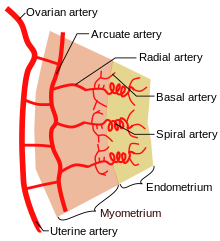Spiral artery

Spiral arteries are small arteries which temporarily supply blood to the endometrium of the uterus during the luteal phase of the menstrual cycle.
In histology, identifying the presence of these arteries is one of the most useful techniques in identifying the phase of the cycle.
The spiral arteries are converted for uteroplacental blood flow during pregnancy, involving:
- Loss of smooth muscle and elastic lamina from the vessel wall.
- 5-10 fold dilation at the mouth of the vessel.
Failure of the physiological conversion of the spiral arteries can cause a number of complications, including intrauterine growth restriction and pre-eclampsia.[2]
References
- ^ Robertson, W. B. (1976). "Uteroplacental vasculature". Journal of Clinical Pathology. 29: 9–17. doi:10.1136/jcp.29.Suppl_10.9. PMC 1347148. PMID 1085779.
- ^ Burton GJ, Woods AW, Jauniaux E, Kingdom JC (June 2009). "Rheological and physiological consequences of conversion of the maternal spiral arteries for uteroplacental blood flow during human pregnancy". Placenta. 30 (6): 473–82. doi:10.1016/j.placenta.2009.02.009. PMC 2697319. PMID 19375795.
- v
- t
- e
Arteries of the abdomen and pelvis
aorta
| Inferior phrenic |
| ||||||||||||||||||||||||
|---|---|---|---|---|---|---|---|---|---|---|---|---|---|---|---|---|---|---|---|---|---|---|---|---|---|
| Celiac |
| ||||||||||||||||||||||||
| Superior mesenteric | |||||||||||||||||||||||||
| Suprarenal | |||||||||||||||||||||||||
| Renal | |||||||||||||||||||||||||
| Gonadal | |||||||||||||||||||||||||
| Lumbar | |||||||||||||||||||||||||
| Inferior mesenteric | |||||||||||||||||||||||||
| Common iliac |
| ||||||||||||||||||||||||
| Median sacral | |||||||||||||||||||||||||
 | This cardiovascular system article is a stub. You can help Wikipedia by expanding it. |
- v
- t
- e










